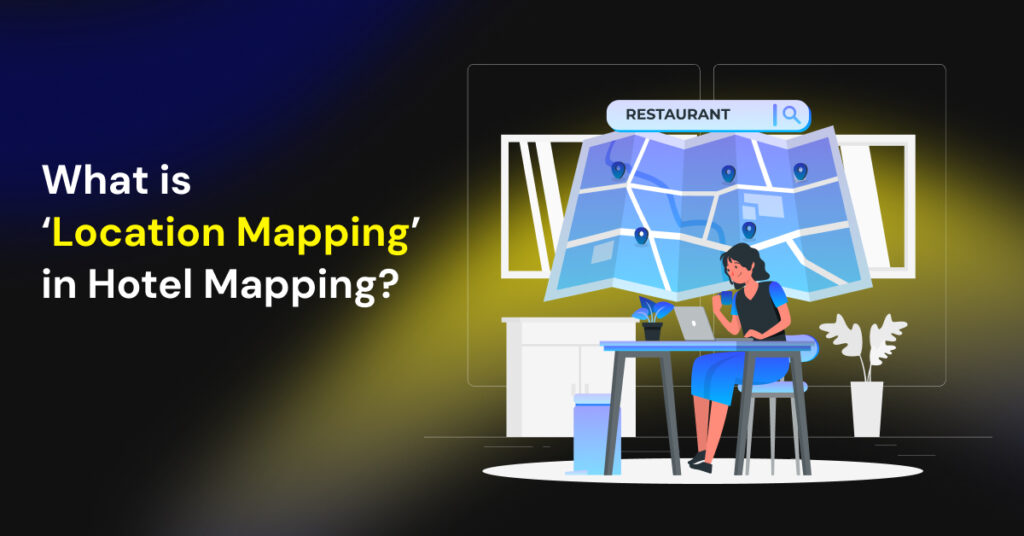Imagine a traveler searches for a hotel “in Rome” and ends up booking one that’s technically within city limits but an hour away from the Colosseum.
While the booking may be valid, the experience isn’t ideal, because the traveler wanted a hotel that was close to the Colosseum but ended up booking one which is quite far from it.
This is why accurate hotel data matters the most and that’s what ‘location mapping’ helps with.
In this blog, we’ll breakdown what “location mapping” means in hotel content, explore the gaps in traditional location data, why it matters to online travel platforms and booking engines, and how evolving data sources like OpenStreetMap (OSM) are helping reshape location accuracy in travel.
To understand the value of location mapping, it’s important to first break down what it actually entails in the context of hotel data. Let’s dive in!
So, What Exactly Does Location Mapping Mean in Hotel Mapping?
Let’s go back to the scenario we talked about in the beginning- the traveler wanted to book a hotel in Rome, but particularly one that was closer to the Colosseum. But, due to inaccurate hotel details, he ended up booking the one that was an hour away from the Colosseum.
Enter location mapping- a process that associates a hotel with its exact physical location not just by city or region name, but by precise geographic coordinates, nearby landmarks, and contextual boundaries.
With the right geolocation and related attributes, location mapping ensures a hotel doesn’t just appear “somewhere in the city” but in the exact spot it’s located, with meaningful context around it.
Modern location mapping goes beyond simple addresses or city names. It includes:
- Geocoding: Assigning exact latitude and longitude coordinates to each hotel.
- Boundary validation: Ensuring hotels fall within accurate city, district, or neighborhood limits.
- Contextual mapping: Associating hotels with nearby airports, transport terminals, and tourist attractions.
- POI proximity analysis: Understanding how close a hotel is to key points of interest (POIs) and using that data in search filters or recommendations.
In the absence of accurate location mapping, a hotel might be tagged under a general location like “New York City,” even if it’s far from popular areas like Times Square or Central Park. This gap can lead to irrelevant search results, frustrated users, and lower conversions.
Now that we know what location mapping is, let’s explore why it’s more than just a technical feature and how it directly impacts the quality of hotel search and booking experiences.
Why Must Online Hotel Booking Platforms Ensure Accurate Location Mapping?
For travelers, location is one of the top factors influencing booking decisions. Whether someone wants to stay near a business district, a beach, a train station, or a popular attraction, vague or incorrect location data can cause frustration and ultimately lead to abandoned bookings. Here’s why accurate location mapping is so important:
Precision in Search = Better Conversions
When hotels are shown in truly relevant locations, travelers are more likely to find what they’re looking for- landmarks, neighborhoods, or transportation hubs and book it.
Hotels Near Attractions = Smoother User Experience
When travelers know a hotel’s proximity to key points of interest (POIs), it helps them make informed decisions and creates an intuitive, map-first booking flow that they love.
Reduced booking errors
Accurate location data helps avoid situations where users unintentionally book hotels far from their intended destination.
Enhanced map-based discovery
As map-based search becomes more common, precise geolocation is essential to power features like “hotels near me” or “within 2km of downtown.”
High Booking Confidence
Accurate location details reduce booking anxiety and increase satisfaction, leading to higher return rates.
As traveler expectations evolve and map-based search becomes mainstream, location mapping is also advancing. Here’s a look at how the role of location data is expanding in modern travel platforms.
Looking Ahead: The Growing Role of Context-Aware Hotel Search
Modern travelers expect more than just availability and price, they want smart recommendations that consider their purpose of visit, desired experience, and proximity to attractions or transit.
As travel platforms evolve to serve more personalized, map-driven user experiences, accurate and dynamic location mapping is non-negotiable. From powering “nearby” filters to enabling hyper-local travel recommendations, location-aware hotel data is at the heart of smarter travel planning.
To support more intelligent location mapping, many platforms are now turning to open, community-driven mapping systems like OpenStreetMap (OSM). These platforms offer rich geospatial data that can help define not just where something is, but what’s around it and how it connects to the broader geography.
For example, using POI data from OSM, a travel platform could identify hotels within walking distance of the Eiffel Tower or within 5 km of an airport making hotel search more intuitive and contextual.
Beyond OSM, location mapping can also be powered by government datasets, proprietary mapping systems, or hybrid approaches that combine multiple sources.
In summary, accurate location mapping is an important capability shaping the future of personalized, location-aware hotel discovery.
Take Away
Location mapping isn’t just a technical detail- it’s a foundational part of the hotel booking experience. It is up to the hotel booking platforms to correctly map hotels to their real-world locations and nearby points of interest, to create more relevant, reliable, and user-friendly search experiences.
As mapping data continues to improve with platforms like OSM and other geospatial tools, the travel industry is well-positioned to offer travelers not just a place to stay- but the right place to stay.







